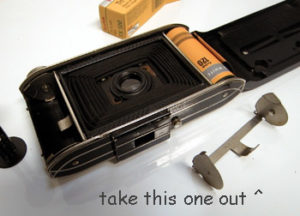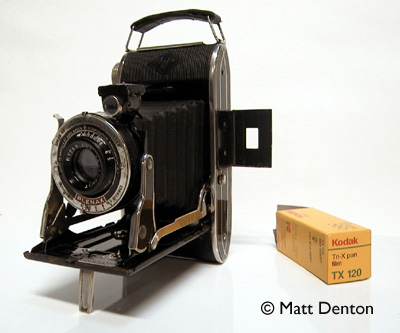- Produced 1930s (1934?) Agfa Ansco Corp, Binghamton, NY USA
- Film type PB20 (620)
- Picture size 6cm x 9cm (6cm x 4.5cm with mask)
- Weight 20oz (567g)
- Lens Hypar Anastigmat 75mm f6.3 (stops to f32)
- Focal range 5′ to infinity
- Shutter Wollensak Plenax
- Shutter speeds T, B, 1/25, 1/50, 1/100
- Viewfinder angled mirror finder plus popup viewfinder
- Exposure meter none
Overview
Compact folding camera, very similar in size and make to the older Zeiss Ikon Nettars, specifically the 515/2. Has some interesting Art Deco styling and a ribbed cloth covering instead of the familiar leatherette. It’s not as well-made as the Nettar, but the shutter is surpisingly strong (good ol’ Wollensak!) and I’ll guess pretty accurate for its age. It cocks and fires in a single motion like my old Kodak 3a, which it resembles a bit in miniature. It’s about the same weight as the Nettar even though it’s very slightly smaller, and though it’s similar in other ways, it simply doesn’t have the qualities that made me call the Nettar ”a little piece of magic.’ On the other hand, it makes a great user and you should easily be able to pick one up for less than half the price of that Zeiss Ikon classic. It also came with other lenses such as the f14 Antar and the Tripar (f11?).
The instructions on the label inside mention a mask for half-frame photos that must be missing from this camera. I see, though, that there are two red windows for advancing the film based on frame size. Speaking of size, this is not a 120 rollfilm camera as I’ve read occasionally but really a 620 that requires a minor modification to take 120 film — see below. Agfa’s designation for 120 was B2 and was PB20 for 620.
Side note: I blew it a little on the test roll. I had trouble framing the shots, for one. With the Nettar the popup viewfinder is spot on. Here I really had no idea what was going to be in the shot, see under ‘Tips & Tricks’ for explanation. If nothing else, I seemed to get more sky than expected. The other thing was that I was shooting Tri-X Professional (ASA 320) but calculating exposure for Tri-X (ASA 400). (Why, Kodak, why?) I was shooting handheld at f32 at the top speed of 1/100 since it was so hot and bright, which would have been correct if it were ASA 400 film. 1/500 at f16 is used as a baseline for ASA 400 film, but 320 is closer to 250 than to 500 so I was basically underexposing by about a stop. I’ll try and remember that next time (or bring a meter, maybe??). For the record, if you can find it, I actually recommend ASA 320 film for some of these older cameras where the top speed is 300 (like the Voigtlander brilliant), for consistency’s sake. Remember, that was the fastest film back when some of these were made.
Nice touch: the shutter speed selector has two pointers, one on the front and one on top so you can see looking down from the top both the shutter speed and the aperture, unlike on most folders that are more front-centric. Yes I made up a word. Also I think I like self-cocking shutters, yes they’re less sophisticated but you get the shot, if you know what I mean.
Repairs
This one came to me in questionable shape, really showing its age with rust spots and pitting on the metal, and the wind knob detached and leaking light. However it looks good where it counts — the bellows are perfect, the shutter as I mentioned is strong and consistent, and the glass is clear and sharp.
After giving it an initial cleaning and a once-over, looks like it’s in pretty good shape mechanically except for the wind knob. Other models I’ve seen for sale have the familiar ‘D’ ring winder, this one has a knob and I suspect it’s an ‘improvement’ simply designed to have another place to put the Agfa logo (they were so earnest about rebranding Ansco after the takeover). The knob and spring-loaded wind mechanism is affixed to the top plate with what looks like glue which has come apart and I’m using contact cement to see if it holds. Looks good so far, I’ll have to remember to go easy on it. Followup: Nope, that didn’t work, I tweaked it off while respooling some 120 film for the 620 Kodak Reflex II. So I put epoxy on that bad boy and now it’s super-solid.
Tips & Tricks
I see this camera advertised occasionally as 120 but it’s really not, it’s 620, which is 120 film on a slightly smaller spool. A 120 spool doesn’t fit inside this camera unless you do what I did and take out the swingout clip on the film side, which is on a roller that pops out much like changing a watch band. Then a 120 roll fits nearly perfectly and the film can then be threaded onto the old 620 takeup spool. Remember to ask for the 620 spool back when you get the film developed!

I thought at first that it didn’t have a tripod mount, then I saw that it in fact has two but they are plugged with little screws, as is the cable release socket. I recognized that one immediately from having a similar protective (?) screw on the Kodak 35 RF but have never seen similar screws in tripod sockets. I wonder if they were meant to be discarded by the consumer rather than inconveniently retained in their respective locations? I can’t imagine having to remember to bring a screwdriver along in case I needed to put it on a tripod.
Other tips: there is a button to release the catch to open the camera, then you pull the metal tab that doubles as a ‘kickstand’ to get it open all the way. You have your choice of using the angled finder or the viewfinder; the angled finder is too small, really, to see much, and the viewfinder feels like guesswork, so you pays your money and you takes your chance with the framing. In practice I found I was erring towards too much sky in my framing, I’ll remember to angle downwards slightly next time or attempt to use the angle finder. To get the camera closed again the angled finder must be in the ‘up’ position and you push two buttons simultaneously to release the lock to get it to fold back in, then the whole thing snaps shut. For film loading, the whole back pops open, handle and all, with a clip catch, and the lower red window A is the one for 6×9 frames.
You’ll need to learn zone focusing and estimating exposure. Also, remember that 6×9 means only 8 frames on a 120 roll, and that if you don’t turn carefully and keep your eye on the red window you can skip right past one of those little digits and end up getting oh, five. Not that I’ve done that, of course.
Related Links
- The manual (!) page about it at butkus.org
- Someone took a nice photo with one and posted it on his Agfa page.
- Should you ever need to reference it, a 120-620 film faq
